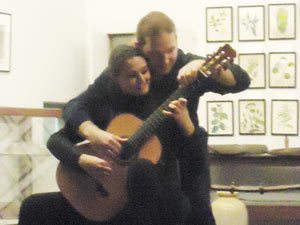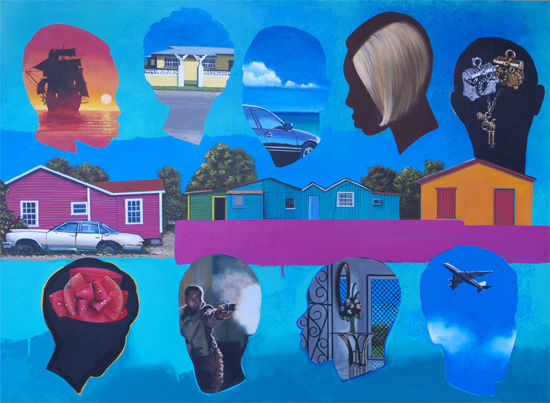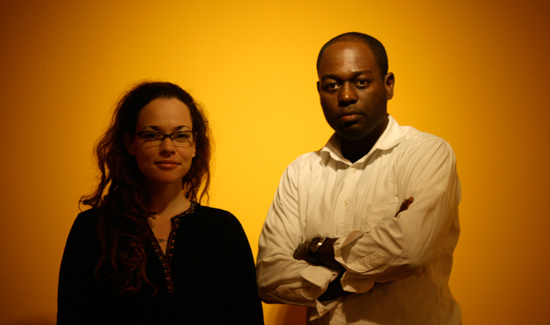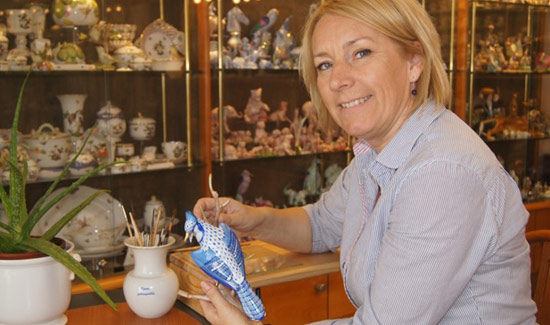
Under the patronage of Governor-General Sir Arthur Foulkes, the Nassau Music Society audience on Friday night was treated to a true “Guitar Heroes” concert, given by the utterly charming classical guitar duo Marco Tamayo and Anabel Montesinos at the Historical Society Museum on Shirley Street. They played to a full 150-person house, which demonstrated the love that so many Bahamians have for the instrument.
Marco Tamayo was born in Cuba, where, having begun to play at three years of age, he studied first with his father and then with Maestro Leo Brouwer of the Philharmonic of La Habana among others. He later studied with Joaquin Clerch at the University of Music in Munich, and with Eliot Fisk at the Mozarteum University of Arts in Salzburg. Mr. Tamayo went on to win the Michele Pittaluga International Guitar Competition in Italy and the Andres Segovia International Guitar Competition in Spain. He is currently Professor of Classical Guitar at the Mozarteum University of Arts in Salzburg.
Anabel Montesinos won the Francisco Tarrega International Competition in Spain as well as the Michele Pittaluga International Guitar Competition in Italy. In fact, Mr. Tamayo met Ms. Montesinos at the competition where, as a 14-year-old prodigy, Ms. Montesinos won the junior division first prize and Mr. Tamayo won the adult division first prize! Knowing a good thing when he saw it, Mr. Tamayo introduced himself to Ms. Montesinos’ mother and married Ms. Montesinos when she came of age. Their beautiful relationship was evidenced in their playing, as they looked into each other’s eyes for barely perceptible cues to keep their duets in sync.
In their performances here, both Tamayo and Montesinos played custom-made Australian Simon Marty guitars, which feature one-piece (as opposed to sandwiched) wooden fronts and curved (as opposed to flat) backs. This construction enables the sound to project extremely well, with microphones neither needed nor wanted. Of course the fine acoustics of the Historical Society Museum enhanced the exquisite tone quality of the guitars, making listening even more pleasurable for the audience.
Mr. Tamayo and Ms. Montesinos have recorded multiple CDs on the Naxos Classical label as well as on the Voice of Lyrics label. In fact, one of Ms. Montesinos’ Naxos CDs was chosen by British Airlines for its music programme on international flights.
This delightful duo, dressed from turtleneck to toe in black, opened the program with Concerto BWV 972 in D Major after A. Vivaldi by J. S. Bach (1685 – 1750), originally written for organ and cembalo and transcribed for two guitars by Eliot Fisk. The classical guitar can easily emulate the sound of a cembalo (a.k.a. harpsichord) because the strings of a cembalo were plucked by quills, just as the strings of a classical guitar are plucked by the musician’s fingernails. The sound of the guitars was delicate and refined on the whole, although the dynamic range was considerably greater than what I expected.
In the first Allegro movement, trills embellished the melodic line, again reinforcing the fact that hearing a classical guitar piece is like hearing a keyboard piece, with scales, trills, ostinato basses, tremolos, and arpeggios as well as chordal accompaniments to the melodic line. These artists are no mere chord strummers; their melodic line technique is as refined and as difficult to master as that of a concert pianist or violinist. In fact, Mr. Tamayo confessed to practicing 11 hours per day in order to achieve professional status. The Andante movement was touching in its feeling of antiquity, allowing us to experience first-hand what it must have felt like to live in the time of Vivaldi and Bach. In the final Allegro movement, Mr. Tamayo’s swiftly-moving left-hand fingers fairly flew as they moved on the neck of the guitar as a pianist would move on a keyboard, while his right-hand fingers absolutely danced as they plucked the individual strings.
Next on the programme was Prima Sonata, di Centone di sonate by Niccolò Paganini (1782 – 1840), written for violin and guitar and transcribed for two guitars by none other than Mr. Tamayo himself. As Mr. Tamayo said, “More beautiful than one guitar are two guitars!” This work comprises two parts: the first of great dramatic intensity and volume, and the second considerably more sprightly, with comical pauses and changes in tempo and mood. Our two guitarists alternated playing the melody, going back and forth in a musical conversation. The last section had a veritable avalanche of scales and slides, and we were off to the races! This work was as taxing to play as any Paganini piece, with no quarter given just because it was being played on a guitar and not on a violin.
The first half of the concert closed with Ms. Montesinos playing the well-known and loved Asturias by Isaac Albéniz (1860 – 1909), a departure from the printed programme which had promised Variations Op. 9 on a Theme of Wolfgang Amadeus Mozart by Fernando Sor (1778 – 1839). Ms. Montesinos’ fast-flying melodic line alternated with sharply punctuating strums. It was truly amazing to hear both the melody and the accompaniment being played by one person on one guitar. Part of the drama of the piece was the insistence of the ostinato bass note that tethered the melody. Then suddenly, like a sigh, the song was gone.
During the interval, I had the pleasure of speaking with Dr. Judson Eneas of Doctors Hospital, Founder of The Gentlemen’s Club in Nassau. Dr. Eneas escorted to the concert 42 of this year’s 53 high school seniors who had been recommended for the honour of participating in the cultural, educational, motivational, social, spiritual, and philosophical enrichment activities sponsored by the club. Dr. Eneas and his youthful charges received a warm welcome from the Nassau Musical Society, and the young gentlemen comported themselves well, as future leaders should.
The opening portion of the second half of the programme featured Mr. Tamayo, who also exercised his artistic license by playing three very interesting and more contemporary songs in place of the listed Sonatina Meridional by Mexican composer Manuel María Ponce (1882 – 1948). The first song was El Vito by Basque composer José de Azpiazu (1912 – 1986). This is a lively Andalusian dance with traditional strumming that is actually supposed to remind us of St. Vitus’ Dance that was rampant in 14th – 17th century Europe and was later diagnosed as chorea, a symptom of the nervous system.
Next we heard Lágrima (Teardrop) by Spanish composer Francisco Tárrega (1852 – 1909). Here, rubato and vibrato were employed to evoke the sweet sadness of the mood, which evolved into wistfulness and finally acceptance as it faded away. The last selection in this group was another work by Tárrega, Recuerdos de la Alhambra (Memories of the Alhambra), a tremolo study that was arranged for the soundtrack of the film The Killing Fields. As in all their offerings, our guest artists’ remarkable independence of fingers and mandolin-like tremolo plucking along with their dramatically soulful expressivity were one again in evidence in this song as performed by Mr. Tamayo.
The remainder of the programme was devoted to the musical collaboration of Duo Tamayo Montesinos, starting with a remarkably entertaining transcription of three Beatles songs by Leo Brouwer. The first offering was Fool on the Hill, a graceful piece with elaborate and complex harmonies, followed in succession by She’s Leaving Home, an expressively poignant rendition replete with pauses and rubato to bring out the harmonic shifts, and finally Penny Lane, a favorite played with sprightly insouciance, a boldness of tone, and rhythmic and melodic riffs by Ms. Montesinos.
Next we heard Los Ojos de Pepa (The Eyes of Pepa), a contradanza from Spanish colonial Cuba by Cuban composer Manuel Saumell (1818 – 1870). Saumell’s contradanzas were written in two parts: “a prima in classical style, followed by a segunda in creolized Cuban folkloric style.”
Last on the programme was the delightful La Serenita, which is Ariel’s Theme from Walt Disney’s The Little Mermaid, transcribed spicily by Mr. Tamayo to a salsa beat. He explained that his beautiful wife as a young girl had been fascinated by Ariel and her song, so this transcription was truly a gift of love.
Thunderous applause led to a very amusing encore of Rondo alla Turca by Wolfgang Amadeus Mozart (1756 – 1791). Prior to playing this piece, Mr. Tamayo assured the audience that the performance method they were about to see was perfectly acceptable, since he and Ms. Montesinos were a married couple. With that, as Ms. Montesinos remained seated and held the guitar, Mr. Tamayo proceeded to stand behind her and then envelop her in his arms so that both could pluck the strings and finger the notes on the guitar’s neck in tandem. The video will enable you to see this extraordinary technique, but the museum’s audience had the added benefit of seeing Mr. Tamayo not-so-surreptitiously steal a few kisses from his bride as they played:
If that grand finale doesn’t convince you that “It’s better in The Bahamas,” nothing will!
Submitted by Anita L. MacDonald, MMus, MS, MBA, GPC/MIS



